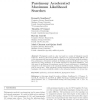77 search results - page 4 / 16 » Reconstructing Phylogenetic Networks Using Maximum Parsimony |
BIBE
2005
IEEE
13 years 10 months ago
2005
IEEE
We have recently demonstrated (La et al, Proteins, 58:2005) that sequence fragments approximating the overall familial phylogeny, called phylogenetic motifs (PMs), represent a pro...
CCECE
2006
IEEE
13 years 10 months ago
2006
IEEE
Phylogenetic trees are commonly reconstructed based on hard optimization problems such as Maximum parsimony (MP) and Maximum likelihood (ML). Conventional MP heuristics for produc...
IJCBDD
2008
13 years 4 months ago
2008
: Phylogenetic search is a key tool used in a variety of biological research endeavors. However, this search problem is known to be computationally difficult, due to the astronomic...
CORR
2007
Springer
13 years 4 months ago
2007
Springer
Abstract—Phylogenetic networks are a generalization of phylogenetic trees that allow for the representation of non-treelike evolutionary events, like recombination, hybridization...
BIBM
2008
IEEE
13 years 10 months ago
2008
IEEE
We present new and novel insights into the behavior of two maximum parsimony heuristics for building evolutionary trees of different sizes. First, our results show that the heuris...

